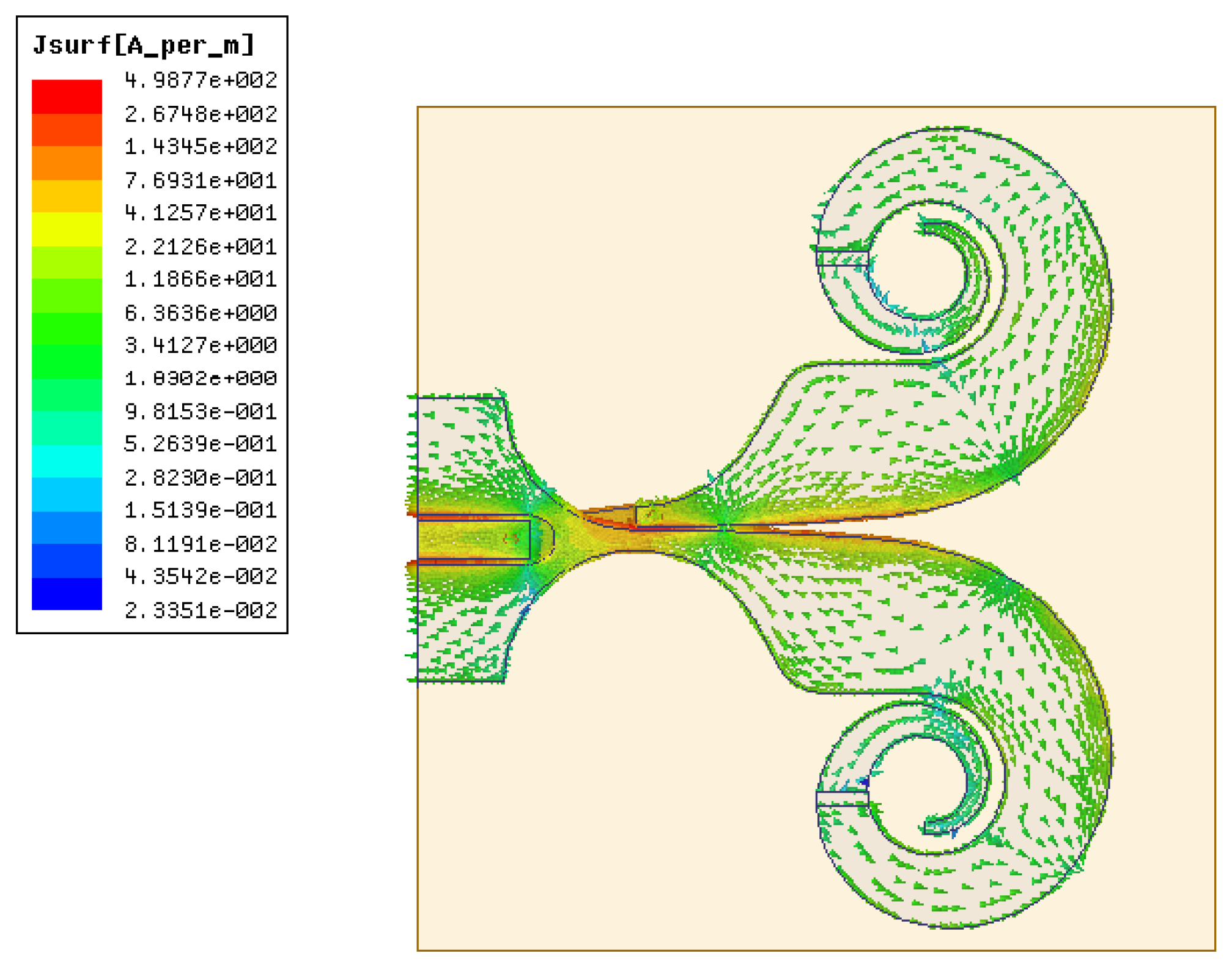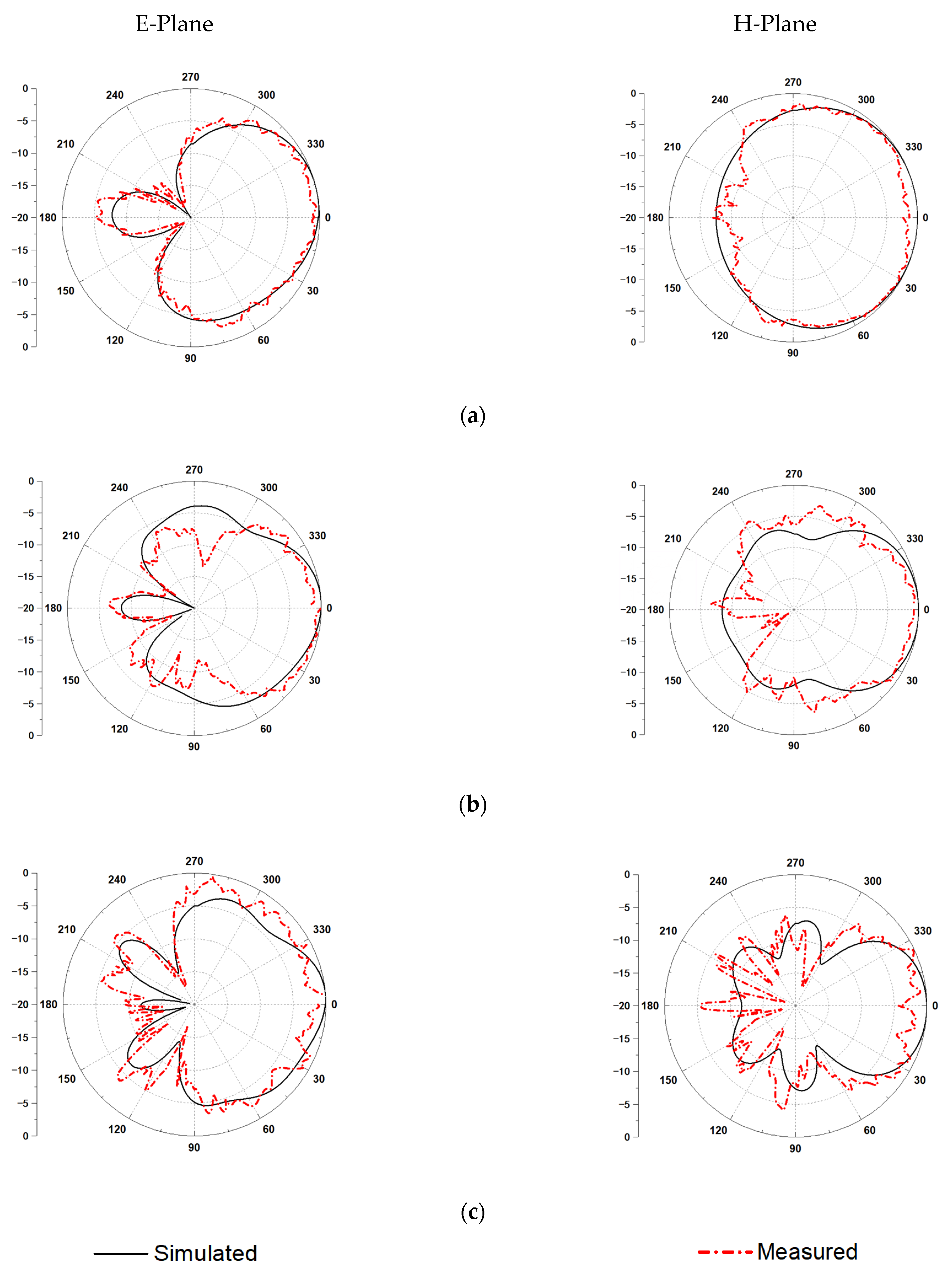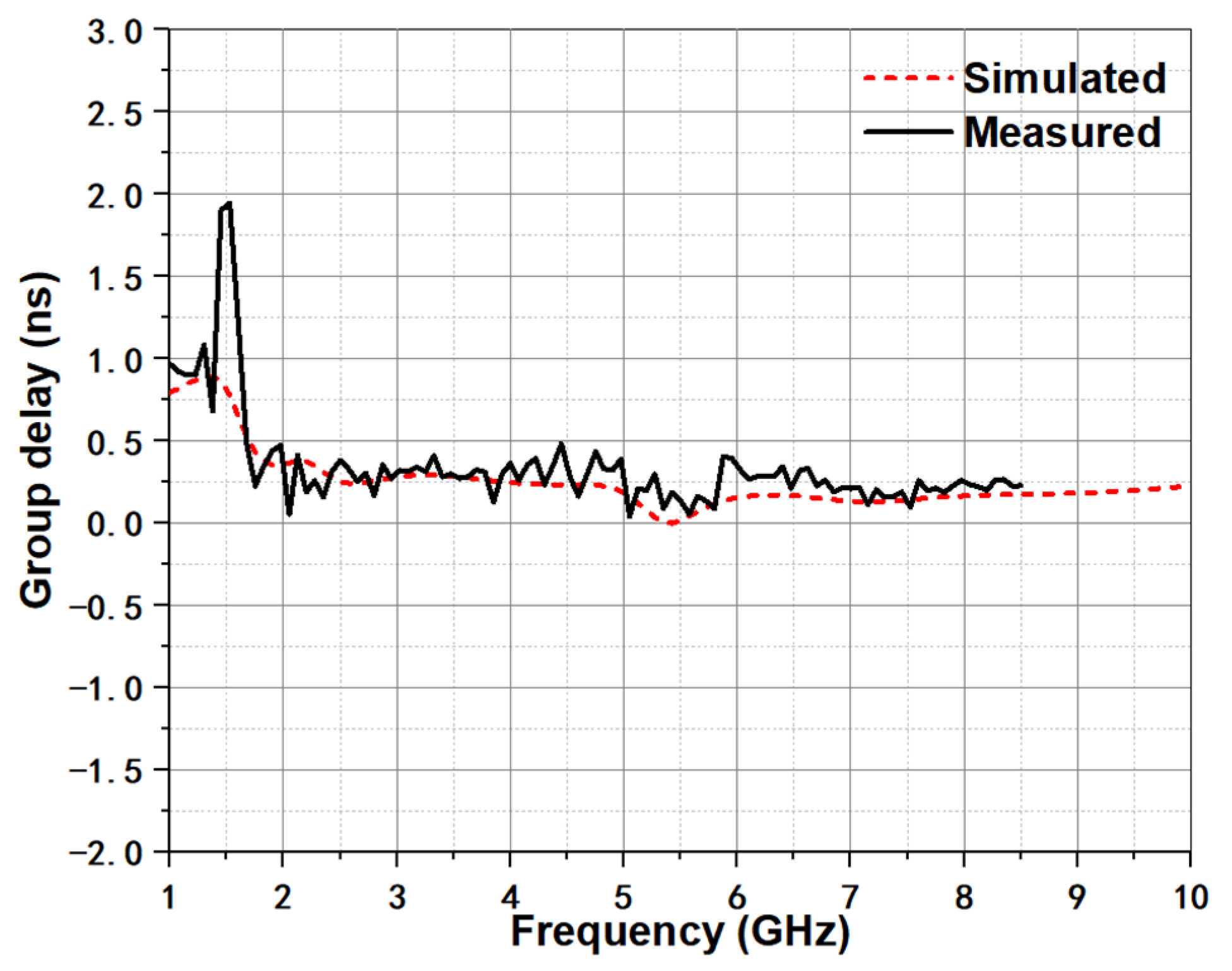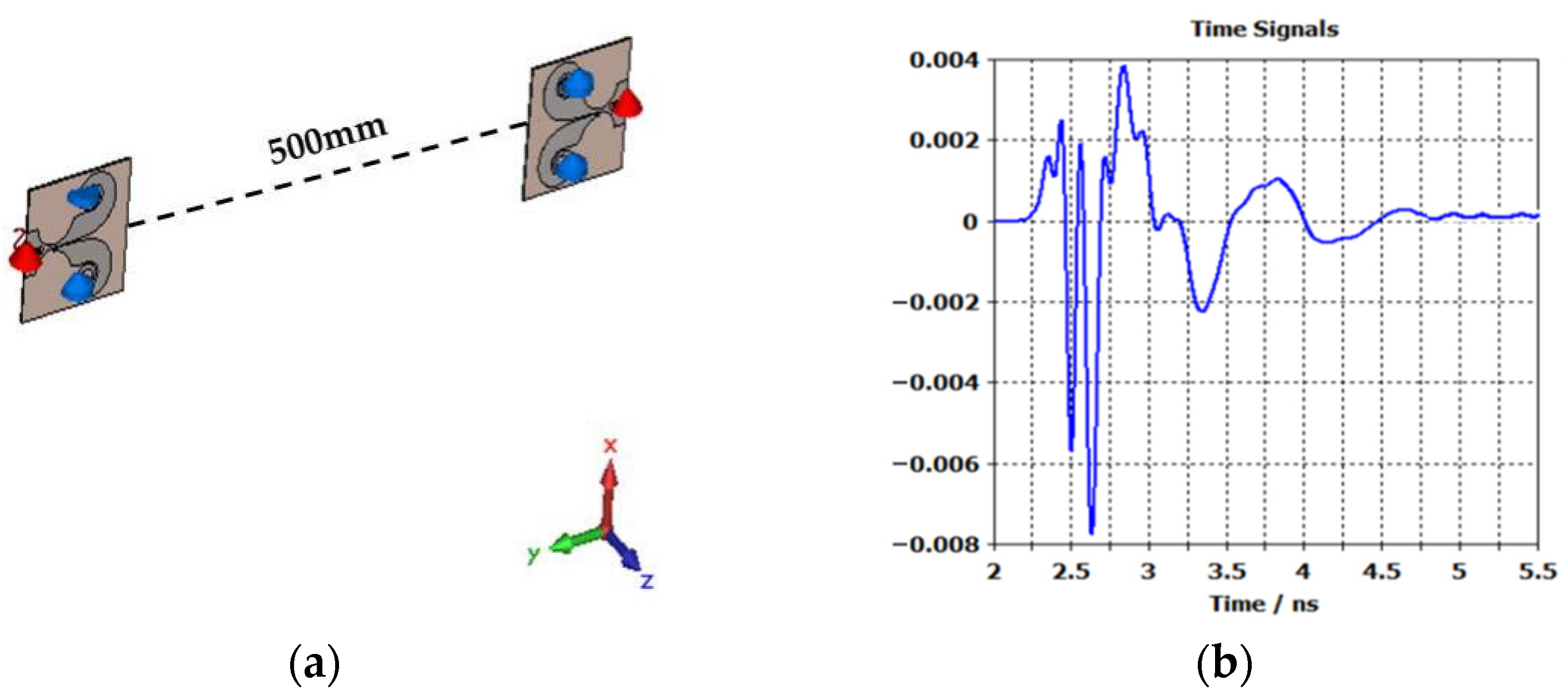Compact TSA with Anti-Spiral Shape and Lumped Resistors for UWB Applications
Abstract
:1. Introduction
2. Slot Antenna Configuration and Design Consideration
2.1. Antenna Configuration
2.2. Parameter Study
3. Results and Discussion
4. Conclusions
Author Contributions
Funding
Conflicts of Interest
References
- Federal Communications Commission (FCC). Revision of Part 15 of the Commision’s Rules Regarding Ultra-Wideband Transmission System; FCC Technical Report, ET-Docket 98-153; FCC: Washington, DC, USA, 2002. [Google Scholar]
- Bahadori, K.; Rahmat-Samii, Y. A Miniaturized elliptic-card UWB antenna with WLAN band rejection for Wireless communications. IEEE Trans. Antennas Propag. 2007, 55, 3326–3332. [Google Scholar] [CrossRef]
- Zhu, F.; Gao, S.; Ho, A.; Chan, H.; Alhameed, R.A.; Li, J.; Xu, J. Compact-size linearly tapered slot antenna for portable ultra-wideband imaging systems. Int. J. RF Microw. Comput.-Aided Eng. 2013, 23, 290–299. [Google Scholar] [CrossRef] [Green Version]
- Raza, A.; Lin, W.; Chen, Y.; Zhang, Y.; Chattha, H.; Sharif, A. Wideband tapered slot antenna for applications in ground penetrating radar. Microw. Opt. Technol. Lett. 2020, 62, 2562–2568. [Google Scholar] [CrossRef]
- Arts, M.; Maaskant, R.; Acedo, E.; Vaate, J. Broadband differentially fed tapered slot antenna array for radio astronomy applications. In Proceedings of the 2009 3rd European Conference on Antennas and Propagation(EuCAP), Berlin, Germany, 23–27 March 2009; pp. 2164–3342. [Google Scholar]
- Schaubert, D.H.; Aas, J.A.; Cooley, M.E.; Buris, N.E. Moment method analysis of infinite stripline-fed tapered slot antenna arrays with a ground plane. IEEE Trans. Antennas Propag. 1994, 2, 1161–1166. [Google Scholar] [CrossRef]
- Nikolaou, S.; Ponchak, G.E.; Papapolymerou, J.; Tentzeris, M.M. Double exponentially tapered slot antenna (DETSA) on liquid crystal polymer (LCP) for UWB applications. In Proceedings of the 2005 IEEE Antennas and Propagation Society International Symposium, Washington, DC, USA, 3–8 July 2005. [Google Scholar]
- Zhu, F.; Gao, S.; Ho, A.T.S.; Raed, A.A.; See, C.H.; Li, J.; Xu, J. Miniaturized tapered slot antenna with signal rejection in 5-6GHz band using a balun. IEEE Antennas Wirel. Propag. Lett. 2012, 11, 507–510. [Google Scholar]
- Abbosh, A.M. Miniaturized microstrip-fed tapered-slot antenna with ultrawideband performance. IEEE Antennas Wirel. Propag. Lett. 2009, 8, 690–692. [Google Scholar] [CrossRef] [Green Version]
- Tiwari, N.; Rao, T.R. Substrate integrated waveguide based antipodal linear tapered slot antenna for 60 GHz wireless communications. Appl. Comput. Electron. 2018, 33, 339–342. [Google Scholar]
- Yang, B.; Yu, Z.; Dong, Y.; Zhou, J.; Hong, W. Compact tapered slot antenna array for 5G millimeter-wave massive MIMO systems. IEEE Trans. Antennas Propag. 2017, 65, 6721–6727. [Google Scholar] [CrossRef]
- Min, Y.Z.; Sheng, X.Y.; Dong, W.W. A compact tapered slot antenna for ultrawideband applications. Microw. Opt. Technol. Lett. 2012, 55, 295–299. [Google Scholar]
- Shao, J.; Fang, G.; Ji, Y.; Tan, K.; Yin, H. A novel compact tapered-slot antenna for GPR applications. IEEE Antennas Wirel. Propag. Lett. 2013, 12, 972–975. [Google Scholar] [CrossRef]
- De Lera Acedo, E.; Garcia, E.; GonzÁlez-Posadas, V.; Vazquez-Roy, J.L.; Maaskant, R.; Segovia, D. Study and design of a differentially-fed tapered slot antenna array. IEEE Trans. Antennas Propag. 2009, 58, 68–78. [Google Scholar] [CrossRef] [Green Version]
- Liu, P.; Zhu, X.; Jiang, Z.H.; Zhang, Y.; Tang, H.; Hong, W. A compact single-layer Q-band tapered slot antenna array with phase-shifting inductive windows for endfire patterns. IEEE Trans. Antennas Propag. 2019, 67, 169–178. [Google Scholar] [CrossRef]
- Pandey, G.K.; Meshram, M.K. A printed high gain UWB vivaldi antenna design using tapered corrugation and grating elements. Int. J. RF Microw. Comput.-Aided Eng. 2015, 25, 610–618. [Google Scholar] [CrossRef]
- Hirano, T.; Hirose, A. Wideband and low direct-coupling tapered slot antenna using electromagnetic bandgap structures. IEEE Trans. Antennas Propag. 2019, 67, 2272–2279. [Google Scholar] [CrossRef]
- Yang, Z.; Guo, L.; Yao, C.; Zhang, Q.; Wang, Z. Ultra-wideband antipodal tapered slot antenna with gradient refractive index metamaterial lens. IEEE Antennas Wirel. Propag. Lett. 2019, 18, 2741–2745. [Google Scholar] [CrossRef]
- Kim, S.; Yu, H.; Choi, K.; Choi, D. Analysis of tapered slot antenna with high gain for 2D indoor wireless positioning. IEEE Access 2019, 7, 54312–54320. [Google Scholar] [CrossRef]
- Alsulaiman, S.; Ashraf, M.A.; Jamil, K.; Shoaib, M.; Alshebieli, S. Compact size tapered slot antenna array for ultra broadband applications. Microw. Opt. Technol. Lett. 2017, 59, 26–31. [Google Scholar] [CrossRef]
- Kim, H.; Jung, C.W. Ultra-wideband endfire directional tapered slot antenna using CPW to wide-slot transition. Electron. Lett. 2010, 46, 1183–1185. [Google Scholar] [CrossRef]
- Costa, J.R.; Medeiros, C.R.; Fernandes, C.A. Performance of a crossed exponentially tapered slot antenna for UWB systems. IEEE Trans. Antennas Propag. 2009, 57, 1345–1352. [Google Scholar] [CrossRef]
- Ebnabbasi, K.; Busuioc, D.; Birken, R.; Wang, M. Taper design of Vivaldi and co-planar tapered slot antenna (TSA) by Chebyshev transformer. IEEE Trans. Antennas Propag. 2012, 60, 2252–2259. [Google Scholar] [CrossRef]
- Kundu, S.; Chatterjee, A. Sharp Triple-notched ultra wideband antenna with gain augmentation using FSS for ground penetrating radar. Wirel. Pers. Commun. 2021, 117, 1399–1418. [Google Scholar] [CrossRef]
- Akazzim, Y.; Kanjaa, M.; Mrabet, O.E.; Jofre, L.; Essaaidi, M. An UWB tapered slot Vivaldi antenna (TSA) with improved characterestics. In Proceedings of the 2019 IEEE 19th Mediterranean Microwave Symposium (MMS), Hammamet, Tunisia, 31 October–2 November 2019. [Google Scholar]
- Guo, L.; Min, M.; Che, W.; Yang, W. A novel miniaturized planar Ultra-wideband antenna. IEEE Access 2019, 7, 2769–2773. [Google Scholar] [CrossRef]
- Fei, P.; Jiao, Y.; Hu, W.; Zhang, F. A miniaturized antipodal Vivaldi antenna with improved radiation characteristics. IEEE Antennas Wirel. Propag. Lett. 2011, 10, 127–130. [Google Scholar]
- Balaji, A.; Karthi, J.; Chinnammal, V.; Malarvizhi, C.; Vanaja, S. A unique technique to improve the performance of antipodal vivaldi antenna for microwave imaging application. In Proceedings of the International Virtual Conference on Robotics, Automation, Intelligent Systems and Energy (IVC RAISE 2020), Erode, India, 15 December 2020. [Google Scholar]
- Delphine, A.; Hamid, M.R.; Seman, N.; Himdi, D. Broadband cloverleaf Vivaldi antenna with beam tilt characteristics. Int. J. RF Micro. Comput.-Aided Eng. 2020, 30, 22158. [Google Scholar] [CrossRef]
- Teni, G.; Zhang, N.; Qiu, J.; Zhang, P. Research on a novel miniaturized antipodal Vivaldi antenna with improved radiation. IEEE Antennas Wirel. Propag. Lett. 2013, 12, 417–420. [Google Scholar] [CrossRef]
- Guo, J.; Tong, J.; Zhao, Q.; Jiao, J.; Huo, J.; Ma, C. An ultrawide band antipodal Vivaldi antenna for airborne GPR application. IEEE Geosci. Remote Sens. Lett. 2019, 16, 1560–1564. [Google Scholar] [CrossRef]
- Wang, Z.; Yin, Y.; Wu, J.; Lian, R. A miniaturized CPW-fed antipodal Vivaldi antenna with enhanced radiation performance for wideband applications. IEEE Antennas Wirel. Propag. Lett. 2015, 15, 16–19. [Google Scholar] [CrossRef]
- Honari, M.M.; Ghaffarian, M.S.; Mirzavand, R. Miniaturized antipodal Vivaldi antenna with improved bandwidth using exponential strip arms. Electronics 2021, 10, 83. [Google Scholar] [CrossRef]
- Siddiqui, J.Y.; Antar, Y.M.M.; Freundorfer, A.P.; Smith, E.C.; Morin, G.A.; Thayaparan, T. Design of an Ultrawideband antipodal tapered slot antenna using elliptical strip conductors. IEEE Antennas Wirel. Propag. Lett. 2011, 10, 251–254. [Google Scholar] [CrossRef]











| Parameter | sub_l | sub_w | ss | gs | gh | gw | l1 | w1 | w2 | ws | rr1 | r0 | arc_rr | Resistors |
|---|---|---|---|---|---|---|---|---|---|---|---|---|---|---|
| Unit | 62 | 53 | 0.2 | 0.35 | 6.6 | 9.78 | 8.6 | 3 | 1.5 | 1 | 3.6 | 10 | 5 | 100 |
| Ref. | Physical Size (mm2) | Electrical size (λ02) | Substrate | Bandwidth (GHz) | Gain (dBi) |
|---|---|---|---|---|---|
| [24] | 38.3 × 34.5 | 0.33 × 0.3 | FR4 | 121% (2.6–10.58) | 2.5–5 |
| [25] | 40 × 45 | 0.31 × 0.35 | Rogers Duroid TM | 144.7% (2.34–14.6) | 2.25–7.75 |
| [26] | 64 × 37.4 | 0.32 × 0.19 | F4BM | 149.6% (1.5–10.4) | 2–7 |
| [27] | 48 × 60 | 0.5 × 0.6 | FR4 | 141.5% (2.4–14) | 3.7–10 |
| [28] | 98 × 110 | 0.46 × 0.51 | FR4 | 148% (1.45–9.8) | 6.28 |
| [29] | 100 × 78 | 0.67 × 0.52 | Taconic TLY-5 | 86% (2–5) | 3–5.19 |
| [30] | 66.4 × 50 | 0.89 × 0.67 | 153% (4–30) | 5–7.5 | |
| [31] | 450 × 600 | 0.45 × 0.6 | Rogers 4350 | 147.8% (0.3–2) | 4–11.5 |
| [32] | 90 × 93.5 | 0.4 × 0.42 | F4B | 171% (1.32–17) | 3.5–9.3 |
| [33] | 158 × 125 | 0.38 × 0.3 | Taconic TLT | 183.7% (0.72–17) | 1–12.5 |
| [34] | 161 × 140 | 0.45 × 0.39 | 174% (0.83–9.8) | 2.5–10.4 | |
| This work | 53 × 63.5 | 0.21 × 0.25 | FR4 | 156.4% (1.2–9.8) | 4–5.2 |
Publisher’s Note: MDPI stays neutral with regard to jurisdictional claims in published maps and institutional affiliations. |
© 2021 by the authors. Licensee MDPI, Basel, Switzerland. This article is an open access article distributed under the terms and conditions of the Creative Commons Attribution (CC BY) license (https://creativecommons.org/licenses/by/4.0/).
Share and Cite
Li, X.-P.; Xu, G.; Duan, C.-J.; Ma, M.-R.; Shi, S.-E.; Li, W. Compact TSA with Anti-Spiral Shape and Lumped Resistors for UWB Applications. Micromachines 2021, 12, 1029. https://doi.org/10.3390/mi12091029
Li X-P, Xu G, Duan C-J, Ma M-R, Shi S-E, Li W. Compact TSA with Anti-Spiral Shape and Lumped Resistors for UWB Applications. Micromachines. 2021; 12(9):1029. https://doi.org/10.3390/mi12091029
Chicago/Turabian StyleLi, Xue-Ping, Gang Xu, Chang-Jiao Duan, Ming-Rong Ma, Shui-E Shi, and Wei Li. 2021. "Compact TSA with Anti-Spiral Shape and Lumped Resistors for UWB Applications" Micromachines 12, no. 9: 1029. https://doi.org/10.3390/mi12091029





